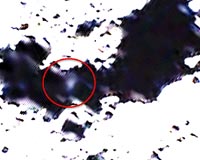|
|
|
NASA'S LCROSS Captures All Phases Of Centaur Impact by Staff Writers  NASA's Lunar CRater Observation and Sensing Satellite (LCROSS) was a smashing success, returning tantalizing data about the Centaur impact before the spacecraft itself impacted the surface of the moon. Last week, plunging headlong into Cabeus crater, the nine LCROSS instruments successfully captured each phase of the impact sequence: the impact flash ... read more
NASA's Lunar CRater Observation and Sensing Satellite (LCROSS) was a smashing success, returning tantalizing data about the Centaur impact before the spacecraft itself impacted the surface of the moon. Last week, plunging headlong into Cabeus crater, the nine LCROSS instruments successfully captured each phase of the impact sequence: the impact flash ... read moreIBEX Explores Galactic Frontier, Releases First-Ever All-Sky Map  Washington DC (SPX) Oct 16, 2009
Washington DC (SPX) Oct 16, 2009NASA's Interstellar Boundary Explorer, or IBEX, spacecraft has made it possible for scientists to construct the first comprehensive sky map of our solar system and its location in the Milky Way galaxy. The new view will change the way researchers view and study the interaction between our galaxy and sun. The sky map was produced with data that two detectors on the spacecraft collected ... more
|
Vietnam says parched Red River at record low
China to be world's third biggest wind power producer: media Cost-cutting NASA eyes three cheap space missions Honduras declares state of emergency amid drought Russia in secret plan to save Earth from asteroid: official Sarkozy scrambles to salvage carbon tax French carbon tax ruled illegal Brazil's Lula signs law cutting CO2 emissions 2009 a 'benign' year of natural disasters: German re-insurer Greenpeace Spain demands Denmark release its director
| |||||||||||||||
| Previous Issues | Oct 16 | Oct 15 | Oct 14 | Oct 13 | Oct 12 |
| . |
Cassini Data Help Redraw Shape Of Solar System Pasadena CA (SPX) Oct 19, 2009
Pasadena CA (SPX) Oct 19, 2009Images from the Ion and Neutral Camera on NASA's Cassini spacecraft suggest that the heliosphere, the region of the sun's influence, may not have the comet-like shape predicted by existing models. In a paper published Oct. 15 in Science Express, researchers from the Johns Hopkins Applied Physics Laboratory present a new view of the heliosphere, and the forces that shape it. "These images ... more Galileo's Jupiter Journey Began Two Decades Ago  Pasadena CA (SPX) Oct 19, 2009
Pasadena CA (SPX) Oct 19, 2009NASA's Galileo spacecraft began what would become a 14-year odyssey of exploration 20 years ago this Sunday, Oct. 18. Galileo was humanity's first emissary to orbit a planet in the outer solar system - Jupiter. Galileo was launched into space aboard the space shuttle Atlantis on Oct. 18, 1989, from Kennedy Space Center, Florida. The crew of Atlantis deployed Galileo out of the shuttle's ... more NSF Contributes To World's Deepest Underground Lab  Berkeley CA (SPX) Oct 19, 2009
Berkeley CA (SPX) Oct 19, 2009The National Science Foundation (NSF) has authorized more than $29 million for the University of California, Berkeley, to create a preliminary plan for turning a former gold mine in South Dakota into the world's deepest laboratory. The grant, approved Sept. 24 by the National Science Board, is for a preliminary design of the Deep Underground Science and Engineering Laboratory (DUSEL) ... more |
. |
| . |
Lunar Lander Floats On Electric-Blue Jets Huntsville AL (SPX) Oct 16, 2009
Huntsville AL (SPX) Oct 16, 2009How do you fly on a world with no atmosphere? Wings won't work and neither do propellers. And don't even try that parachute! NASA engineer Brian Mulac has the answer. "All it takes is practice, practice, practice," he says. "And of course, thrusters." The space agency is perfecting the art using a prototype lunar lander at the Marshall Space Flight Center: "What we've got here is a 'flying ... more How The Moon Produces Its Own Water  Paris, France (ESA) Oct 16, 2009
Paris, France (ESA) Oct 16, 2009The Moon is a big sponge that absorbs electrically charged particles given out by the Sun. These particles interact with the oxygen present in some dust grains on the lunar surface, producing water. This discovery, made by the ESA-ISRO instrument SARA onboard the Indian Chandrayaan-1 lunar orbiter, confirms how water is likely being created on the lunar surface. It also gives scientists an ... more "Barcelona Process" Established To Guide Search For Habitable Exoplanets  Barcelona, Spain (SPX) Oct 14, 2009
Barcelona, Spain (SPX) Oct 14, 2009Exoplanet scientists from around the world gathered in Barcelona from September 14 to 18 to debate and reach a consensus on defining guidelines for a new roadmap with the ultimate objective of finding habitable, and potentially inhabited, planets outside of our Solar System. In addition they reached an agreement on an appropriate framework for developing such an initiative. ... more |
. |
| Previous Issues | Oct 16 | Oct 15 | Oct 14 | Oct 13 | Oct 12 |
| The contents herein, unless otherwise known to be public domain, are Copyright 1995-2009 - SpaceDaily. AFP and UPI Wire Stories are copyright Agence France-Presse and United Press International. ESA Portal Reports are copyright European Space Agency. All NASA sourced material is public domain. Additional copyrights may apply in whole or part to other bona fide parties. Advertising does not imply endorsement, agreement or approval of any opinions, statements or information provided by SpaceDaily on any web page published or hosted by SpaceDaily. Privacy statement |